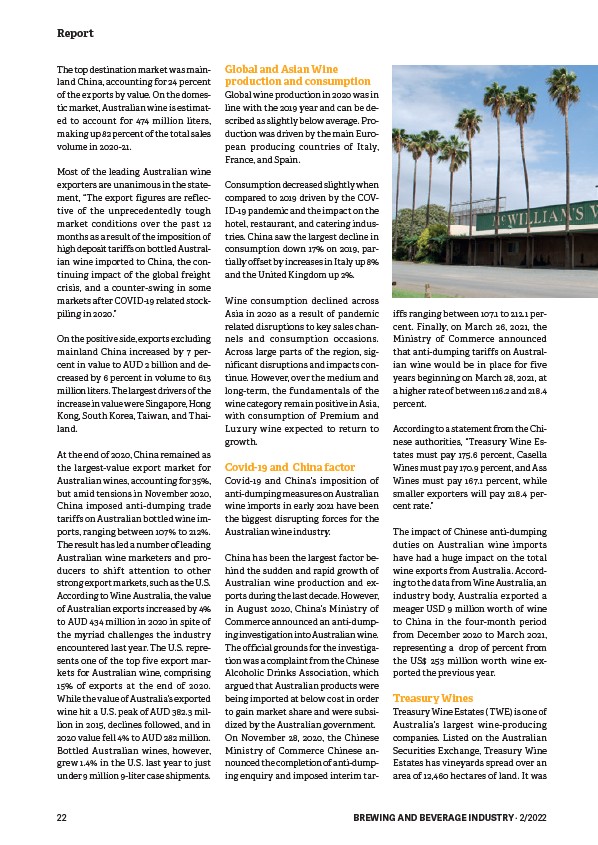
Report
iffs ranging between 107.1 to 212.1 percent.
Finally, on March 26, 2021, the
Ministry of Commerce announced
that anti-dumping tariffs on Australian
wine would be in place for five
years beginning on March 28, 2021, at
a higher rate of between 116.2 and 218.4
percent.
According to a statement from the Chinese
authorities, “Treasury Wine Estates
must pay 175.6 percent, Casella
Wines must pay 170.9 percent, and Ass
Wines must pay 167.1 percent, while
smaller exporters will pay 218.4 percent
rate.”
The impact of Chinese anti-dumping
duties on Australian wine imports
have had a huge impact on the total
wine exports from Australia. According
to the data from Wine Australia, an
industry body, Australia exported a
meager USD 9 million worth of wine
to China in the four-month period
from December 2020 to March 2021,
representing a drop of percent from
the US$ 253 million worth wine exported
the previous year.
Treasury Wines
Treasury Wine Estates ( TWE) is one of
Australia’s largest wine-producing
companies. Listed on the Australian
Securities Exchange, Treasury Wine
Estates has vineyards spread over an
area of 12,460 hectares of land. It was
Global and Asian Wine
production and consumption
Global wine production in 2020 was in
line with the 2019 year and can be described
as slightly below average. Production
was driven by the main European
producing countries of Italy,
France, and Spain.
Consumption decreased slightly when
compared to 2019 driven by the COVID
19 pandemic and the impact on the
hotel, restaurant, and catering industries.
China saw the largest decline in
consumption down 17% on 2019, partially
offset by increases in Italy up 8%
and the United Kingdom up 2%.
Wine consumption declined across
Asia in 2020 as a result of pandemic
related disruptions to key sales channels
and consumption occasions.
Across large parts of the region, significant
disruptions and impacts continue.
However, over the medium and
long-term, the fundamentals of the
wine category remain positive in Asia,
with consumption of Premium and
Luxury wine expected to return to
growth.
Covid-19 and China factor
Covid-19 and China’s imposition of
anti-dumping measures on Australian
wine imports in early 2021 have been
the biggest disrupting forces for the
Australian wine industry.
China has been the largest factor behind
the sudden and rapid growth of
Australian wine production and exports
during the last decade. However,
in August 2020, China’s Ministry of
Commerce announced an anti-dumping
investigation into Australian wine.
The official grounds for the investigation
was a complaint from the Chinese
Alcoholic Drinks Association, which
argued that Australian products were
being imported at below cost in order
to gain market share and were subsidized
by the Australian government.
On November 28, 2020, the Chinese
Ministry of Commerce Chinese announced
the completion of anti-dumping
enquiry and imposed interim tar-
The top destination market was mainland
China, accounting for 24 percent
of the exports by value. On the domestic
market, Australian wine is estimated
to account for 474 million liters,
making up 82 percent of the total sales
volume in 2020-21.
Most of the leading Australian wine
exporters are unanimous in the statement,
“The export figures are reflective
of the unprecedentedly tough
market conditions over the past 12
months as a result of the imposition of
high deposit tariffs on bottled Australian
wine imported to China, the continuing
impact of the global freight
crisis, and a counter-swing in some
markets after COVID-19 related stockpiling
in 2020.”
On the positive side, exports excluding
mainland China increased by 7 percent
in value to AUD 2 billion and decreased
by 6 percent in volume to 613
million liters. The largest drivers of the
increase in value were Singapore, Hong
Kong, South Korea, Taiwan, and Thailand.
At the end of 2020, China remained as
the largest-value export market for
Australian wines, accounting for 35%,
but amid tensions in November 2020,
China imposed anti-dumping trade
tariffs on Australian bottled wine imports,
ranging between 107% to 212%.
The result has led a number of leading
Australian wine marketers and producers
to shift attention to other
strong export markets, such as the U.S.
According to Wine Australia, the value
of Australian exports increased by 4%
to AUD 434 million in 2020 in spite of
the myriad challenges the industry
encountered last year. The U.S. represents
one of the top five export markets
for Australian wine, comprising
15% of exports at the end of 2020.
While the value of Australia’s exported
wine hit a U.S. peak of AUD 382.3 million
in 2015, declines followed, and in
2020 value fell 4% to AUD 282 million.
Bottled Australian wines, however,
grew 1.4% in the U.S. last year to just
under 9 million 9-liter case shipments.
22 BREWING AND BEVERAGE INDUSTRY · 2/2022